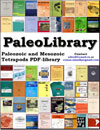
Complete Data Base of Paleozoic and Mesozoic Tetrapods.
Paleo-News and illustrations. Big electronic PDF-library.
| |
| PaleoNews |
| Classification |
| Books and Articles |
| Contact |
| Forum |
сайт о динозаврах
рейтинг сайтов
Free Counter
myspace hit counter
3D Camouflage in an Ornithischian Dinosaur |
September 19, 2016: Highlights Preserved pigments in the dinosaur Psittacosaurus suggest countershading camouflage Abstract Countershading was one of the first proposedmechanisms of camouflage. A dark dorsum and light ventrum counteract the gradient created by illumination from above, obliterating cues to 3D shape. Because the optimal countershading varies strongly with light environment , pigmentation patterns give clues to an animal’s habitat. Indeed, comparative evidence from ungulates shows that interspecific variation in countershading matches predictions: in open habitats, where direct overhead sunshine dominates, a sharp dark-light color transition high up the body is evident; in closed habitats (e.g., under forest canopy), diffuse illumination dominates and a smoother dorsoventral gradation is found. We can apply this approach to extinct animals in which the preservation of fossil melanin allows reconstruction of coloration. Here we present a study of an exceptionally well-preserved specimen of Psittacosaurus sp. from the Chinese Jehol biota. This Psittacosaurus was countershaded with a light underbelly and tail, whereas the chest was more pigmented. Other patterns resemble disruptive camouflage, whereas the chin and jugal bosses on the face appear dark. We projected the color patterns onto an anatomically accurate life-sizemodel in order to assess their function experimentally. The patterns are compared to the predicted optimal countershading from the measured radiance patterns generated on an identical uniform gray model in direct versus diffuse illumination. These studies suggest that Psittacosaurus sp. inhabited a closed habitat such as a forest with a relatively dense canopy. Summary Countershading camouflage uses a dark-to-light gradient from back to belly to counter the light-to-dark gradient created by illumination. The body appears flatter and less conspicuous. Vinther et al. use 3D reconstruction and radiance modeling to show that the dinosaur Psittacosaurus was countershaded and cryptic in a forested environment. Jakob Vinther, Robert Nicholls, Stephan Lautenschlager, Michael Pittman, Thomas G. Kaye, Emily Rayfield, Gerald Mayr, and Innes C. Cuthill (2016)3D Camouflage in an Ornithischian Dinosaur. Current Biology 26 (1-7).
|
